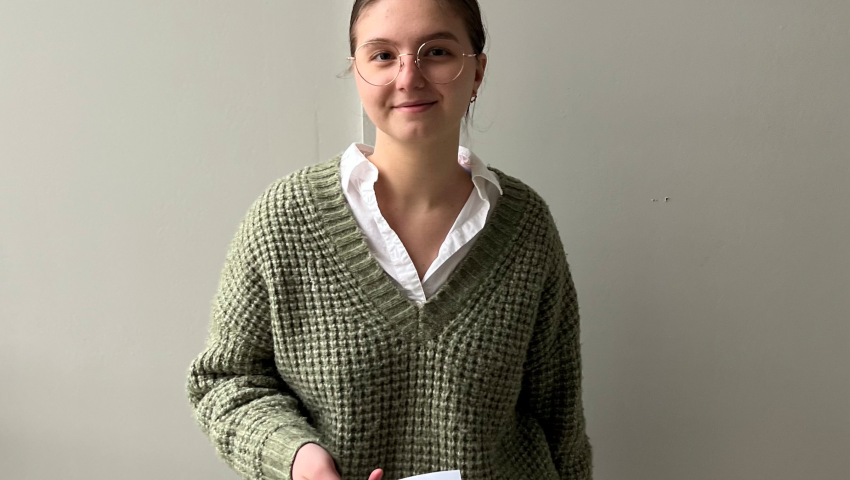
Master of Public Health student creates rabies awareness curriculum for elementary students
Faith Fursman, a Master of Public Health student at the University of Kentucky College of Public Health, took on a critical public health challenge during her practicum with the Kentucky Department for Public Health: how to teach children about the risks of rabies.
Rabies is a viral disease that attacks the central nervous system and can be deadly to humans if not treated immediately. It’s spread to humans through bites or scratches from infected animals — most commonly bats, raccoons, skunks and foxes.
Children are the most at-risk for rabies because they may not yet know how to interact with animals and may not report being scratched or bitten right away.
Kentucky’s State Public Health Veterinarian Kelly Giesbrecht, D.V.M., M.P.H., guided Fursman through her practicum, which was paid for by the Kentucky Department for Public Health’s (KDPH) Center for Foundational Health.
Through this work, Fursman developed an engaging, age-appropriate rabies education curriculum to equip elementary school students with the knowledge to protect themselves from this life-threatening disease. Her innovative work combined fun and education, filling a significant gap in resources for one of the most vulnerable populations.
Fursman’s journey to public health began with a childhood fascination for science and medicine.
“I was always interested in science and medicine but knew I didn’t want to be directly patient-facing. After talking to my mom while I was in high school, she suggested I look into what public health is,” Fursman said.
This suggestion set her on a path that aligned her love for science with her desire to make a difference.
When it came time to choose a practicum placement, Fursman was excited about the opportunity to work with KDPH based on its wide range of opportunities.
“They offered a lot of different project focuses and responsibilities, so there was something for everyone,” she said. “All the information needed for the application and the person who helped answer questions were very helpful in the process and readily available as needed.”
KDPH’s environment, which emphasized adaptability and support, made it the ideal place for Fursman to explore her interest in infectious and vector-borne diseases.
The public health student first began working with Giesbrecht in Spring 2023, creating a REDCap project for bat rabies data. Giesbrecht mentioned wanting to develop educational materials for schools in the future, and Fursman turned this idea into her practicum project.
Fursman’s decision to pursue rabies education was sparked by her desire to address knowledge gaps and provide resources for such a vulnerable population.
“There weren’t any readily available resources on rabies for kids in Kentucky, when kids are one of the most vulnerable populations,” she said.
Her efforts were also inspired by Giesbrecht’s enthusiasm.
“Dr. G is extremely passionate about rabies awareness, and it shows in all the individual projects and presentations she puts together,” Fursman said. “It’s easier for me to become really passionate about a topic if the person teaching me is as well.”
Giesbrecht gave Fursman a list of essential topics to start the project. Fursman researched each topic thoroughly, drawing from reputable sources such as the Centers for Disease Control and Prevention (CDC) and the Kentucky Department of Fish and Wildlife. Over seven months, she created a curriculum that blended fun and education, incorporating interactive games, coloring pages, word searches and a frequently asked questions section.
“I created activity sheets, information packets and multiple presentations aimed at elementary students, spending hours researching not only the topic but how to adequately express all the key topics to a young audience,” Fursman said.
Her project resulted in a comprehensive rabies education curriculum tailored for elementary school students. The curriculum features engaging presentations, an activity boo, and classroom activities with two different curriculums designed for age groups, K-2 and 3-5.
Fursman and Giesbrecht tested the rabies education curriculum with visitors to the Kentucky State Fair. The interactive materials, combined with hands-on activities, received overwhelmingly positive feedback. The games and prizes were a hit with children, while parents appreciated the informative materials accompanying the fun.
“Overall, I would say we were very successful in communicating our message to attendees,” Fursman said.
The fair also opened new doors for the project. “We built connections with people who said they would love to have our materials presented, like at a children’s library and a STEM program,” she said.
Fursman and her team are exploring options for classroom presentations in the spring, as well as the potential of sending the materials to all schools in Kentucky.
Giesbrecht praised Fursman’s dedication and adaptability.
“I find that no matter what project I throw at Faith, she learns how to deal with the new information or new database, such as learning REDCap, and will complete it,” Giesbrecht said. “This is an important accomplishment to help our kids learn about the risk of rabies and how to prevent it.”
Reflecting on her experience, Fursman said the biggest thing she learned during this project was how to cater materials to specialized populations. She plans to use this skill in her future career, whether working in outbreak surveillance or addressing disparities in access to prescriptions within the pharmaceutical industry.
“To do this successfully, I’ll need to be able to communicate with whichever population I’m working with in order to help decrease the disparities,” she explained, highlighting how her practicum experience has equipped her with tools to bridge gaps in public health education and access.